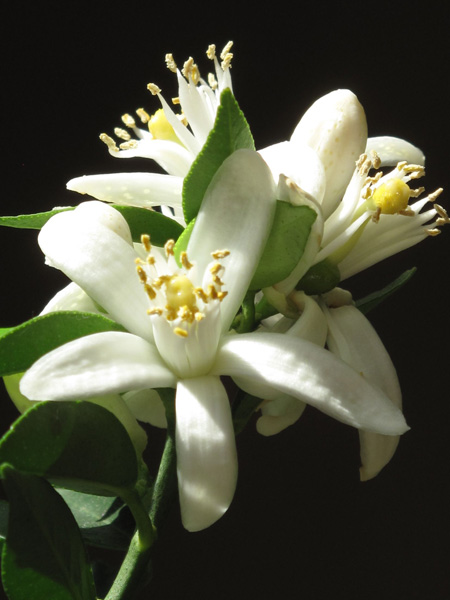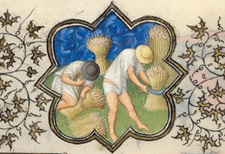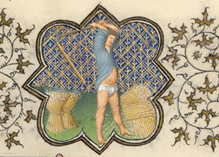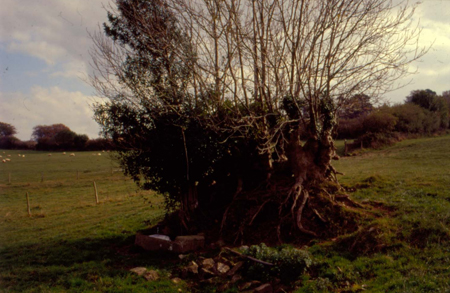Archive for March, 2011
Friday, March 25, 2011

Above: Roundel, Annunciation to the Virgin, 1500???1510. South Netherlandish. Colorless glass, vitreous paint, and silver stain. The Metropolitan Museum of Art, New York, The Cloisters Collection, 1972 (1972.245.1). See the Collection Database to learn more about this work of art.
March 25 has been a significant date???both religious and secular???throughout Western history. In the Julian calendar, today’s date marked the vernal equinox. In parts of the medieval West, it was used as the first day of the calendar year, although Roman traditions of celebrating the new year in January continued throughout the Middle Ages. (See last year’s post “The January Feast,” January 15, 2010.) Read more »
Tags: Annunciation, The Golden Legend
Posted in The Medieval Calendar | Comments (1)
Friday, March 18, 2011

Clusters of waxy white orange blossom produce the distinctive and delicious scent that now perfumes the arcades of Cuxa Cloister. The bitter oranges that winter over indoors at The Cloisters are in their second week of bloom. Photograph by Corey Eilhardt
When distilled, the fragrant flowers of the bitter orange yield an essential oil that rises to the top of the vessel. The water that remains once the oil has been drawn off is known as orange flower water. This water has long been used in Middle Eastern cuisines, to perfume sugar syrups used in sweets and pastries, and to flavor beverages. Read more »
Tags: bitter orange, Citrus aurantium, distillery, essential oil, fragrance, hydrosol, myrtifolia, neroli, orange blossom, perfume, still
Posted in Gardening at The Cloisters | Comments (3)
Friday, March 11, 2011
At certain times of the year in the medieval rural landscape, it would have been common to see plump sheaves of grain standing in sunny fields like so many golden tokens of agricultural wealth and prosperity, as numerous depictions???even in some of the most sumptuous manuscripts of the Middle Ages, such as the Belles Heures of the duke of Berry???attest. At harvest, the wheat was cut at the base of the stalk with a sickle and then gathered up in large armfuls and tied about the middle. The resulting bundles were left spaced and standing upright in the fields, which allowed them to dry even if it happened to rain before they could carted off for threshing.


Details of illuminations from Folio 8r and Folio 9r from the Belles Heures of Jean de France, duc de Berry, 1405???1408/9.
Read more »
Tags: barley, Belles Heures, blazon, Bolton, caraway, carrot, Cheshire, Comyn, cumin, Cuminum cyminum, garb, Geoffrey Chaucer, gold, grain, Grosvenor, heraldic, heraldry, John of Gaunt, oat, Owain Glynd??r, parsley, rye, Scrope, sheaf, sheaves, shield, wheat
Posted in Plants in Medieval Art | Comments (1)
Friday, March 4, 2011

Many relics of medieval woodland management techniques, such as this coppice stool, can be found in the British countryside.
Although evidence of medieval systems of woodland management can be found throughout Europe, the following post is based on studies of ancient British woodlands and their management, especially as discussed in the work of Dr. Oliver Rackham, an acknowledged authority in the field. Updated versions of many of Dr. Rackham’s older works have been revised and reprinted. His most recent book, Woodlands, was published in 2009. The term “ancient woodland” is used to designate areas that have been continuously wooded since at least 1600 and is thus applied to woodlands of medieval date.
Pollarding, a technique of woodland management discussed in last week’s post, afforded a valuable renewable resource. A pollarded tree was pruned back drastically at the top, above the browse line, in order to protect the crop from grazing animals in areas where livestock had access to the trees. Read more »
Tags: ash, coppice stool, coppicing, elder, hazel, hornbeam, lime, oak, pollard, pollarding, pruning, stool, timber, tree, understory, willow, woodbank, woodland
Posted in Medieval Agriculture | Comments (2)





